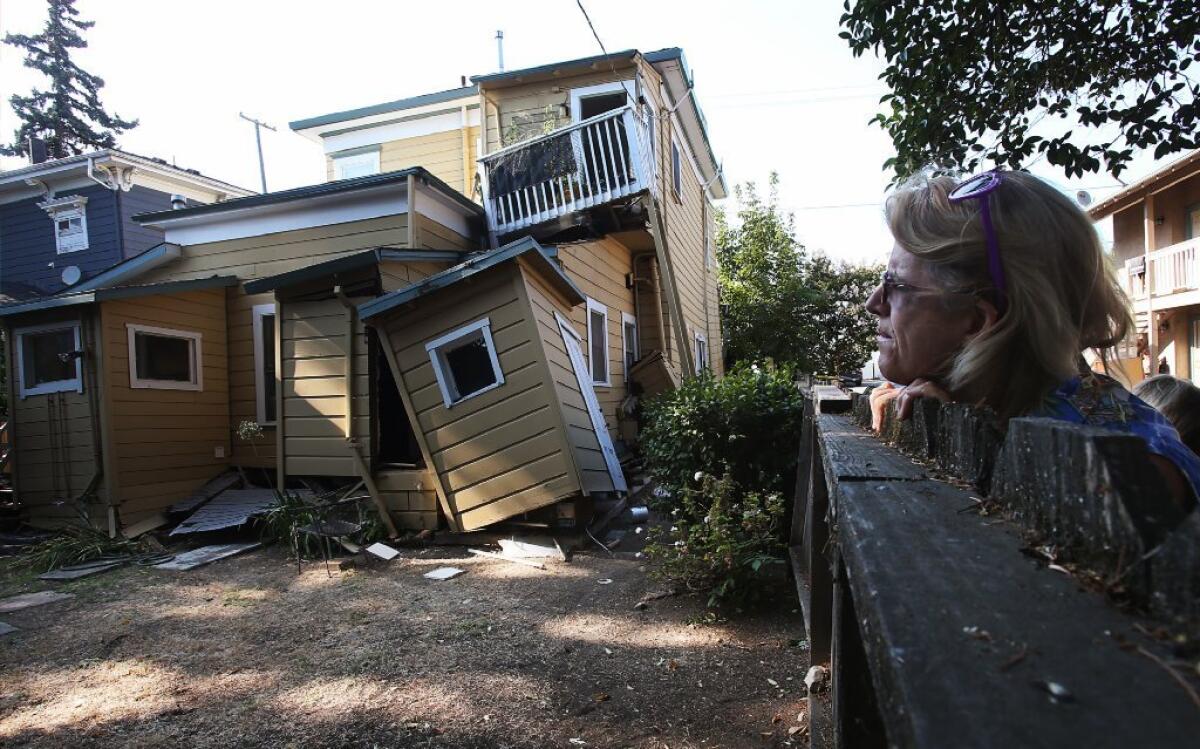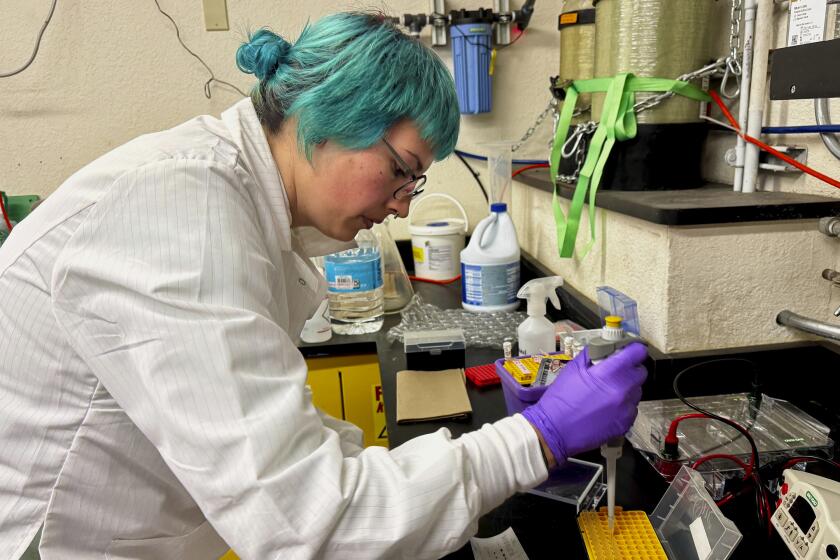Scientists think your cellphone could help them warn of earthquakes

A woman eyees a red-tagged home near downtown Napa after a magnitude 6.0 earthquake in August 2014. An early alert system gave a 10-second warning before the quake hit.
- Share via
Your smartphone is a camera, a calculator, a flashlight and a pedometer. Scientists believe it could be part of an earthquake early-warning system too.
It turns out that the GPS sensors built into most smartphones are sensitive enough to detect the earliest signs of quakes that are magnitude 7 and stronger, new research shows. The data they collect could be used to give nearby communities a few seconds’ notice that seismic waves are headed their way.
“The GPS on a smartphone is shockingly good,” said study leader Sarah Minson, a geophysicist at the U.S. Geological Survey in Pasadena. “If you take your phone and move it six inches to the right, it knows with surprising accuracy that it moved six inches to the right — and that is exactly what we want to know when studying earthquakes.”
In the past, scientists have examined whether the accelerometers that come standard in smartphones are good enough to detect early signs of earthquakes. (One of the jobs of these accelerometers is to let the phone know whether the user is holding it vertically or horizontally so that the orientation of the screen is correct.)
In this study, the researchers were interested in whether the GPS data our phones collect could be useful in earthquake detection as well.
Minson and her coauthors created a hypothetical data set of cellphone readings that would have been captured during a magnitude 7 earthquake on the Hayward fault in Northern California.
They also looked at data recorded by state-of-the-art GPS-based earthquake sensors in Japan during the magnitude 9 Tohoku quake in 2011. This information was much more detailed than what a typical smartphone could get, so the researchers used only what a phone would record and disregarded the rest.
With both sets of data in hand, the researchers tested whether the phones would be able to detect an earthquake if it occurred, pin down its location and determine its magnitude.
The obvious challenge to using mobile phones to register an earthquake is that they are often in motion — bumping around when we drive over a pothole, trip on a curb or bound up the stairs.
Douglas Given, coordinator of the ShakeAlert earthquake early-warning system at the USGS, described the conundrum: “You have a lot of cellphones bouncing around all over the place, and you are trying to measure what the ground is doing. So how do you tell the difference?”
To solve this problem, the researchers came up with something called a trigger — a set of criteria that would distinguish between an actual earthquake and a bunch of cellphones on a bus getting jostled as it went over a big bump.
With the hypothetical Hayward fault earthquake, the trigger they decided on was if a phone and its four closest neighbors recorded the same amount of displacement at the same time and the same could be said for 100 phones in the same area. Then, and only then, the researchers’ early-warning system would register that a quake had occurred and send an alert to other communities.
The researchers used the Tohoku quake data to see whether it would be possible to keep the rate of false alarms below one of every 2 million apparent detections. It was — as long as 103 phones met the trigger criteria.
The results were published Friday in the journal Science Advances.
Yehuda Bock, a UC San Diego geodesist who studies ways of using GPS to detect quakes and other natural hazards, said that although the paper is technically sound, he is not sure that the cellphone network would be very practical.
“I’m a little skeptical it will work in a real-world situation,” said Bock, who was not involved in the research. “I think a system like that would false-alarm more than they claim in the paper.”
Minson acknowledges that the system may not be quite as accurate in the real world as it appears to be on paper. Real-world tests will help her find out. Those will come next year, when she and her colleagues will test their early-warning system in Chile with a few hundred smartphones.
“Hopefully,” she said, “this is going to be a good learning experience for us.”
Minson said the main benefit of crowd-sourcing earthquake detection is that it’s inexpensive, because the phones have already been paid for. All the experts would have to do is write an app to connect them, and then find a central computer somewhere to collect the data.
“The cost is essentially zero, especially since people buy new phones every two years or so to have the latest-and-greatest model,” she said.
But don’t expect to join your cellphone to an earthquake early-warning system anytime soon.
“The point of this paper is that the type of measurements that are being made by smartphones have the potential to be useful in earthquakes,” said Thomas Heaton, a professor of geophysics at Caltech and a coauthor of the study. “That’s quite a big step from actually making it useful in earthquakes.”
In California, there is little incentive to deploy a system of earthquake-sensing smartphones. Scientists are already building an earthquake early-warning system that could go public within two years if enough funding comes through. That system relies on hundreds of science-grade sensors, some of which are so sensitive that they can detect the gravitational pull of the moon.
A prototype system gave San Francisco eight seconds of warning that shaking from the 2014 Napa earthquake was on its way. That may not sound like a lot of time, but when it comes to quakes, even a few seconds can matter.
“If you are a driver you can pull over, if you are at work you can get under your desk, and if you are a surgeon you can retract your scalpel,” Minson said.
A smartphone network here could augment the official one, the researchers said. And in places where there is no alternative, the crowd-sourced solution might make more sense.
“If we could make it work well,” Heaton said, “then the next thing to think about is exporting that technology to other parts of the world.”
Science rules! Follow me on Twitter @DeborahNetburn and “like” Los Angeles Times Science & Health on Facebook.







